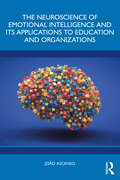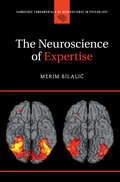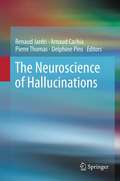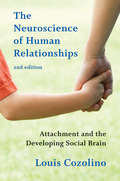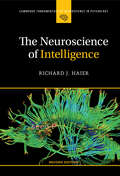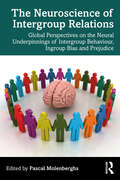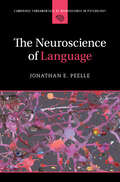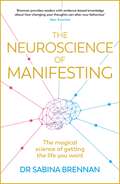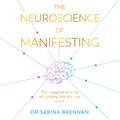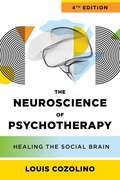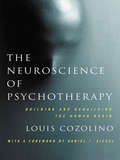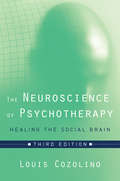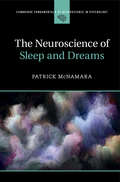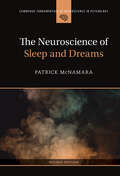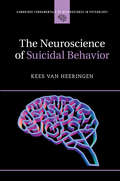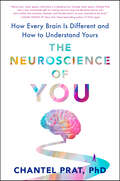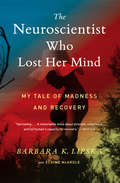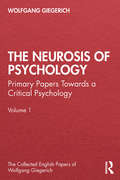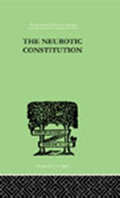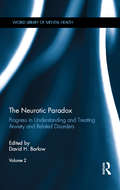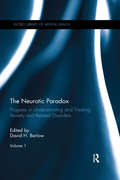- Table View
- List View
The Neuroscience of Emotional Intelligence and Its Applications to Education and Organizations
by João AscensoThis book provides a clear understanding of the neuromechanisms of emotional intelligence and its applications to education and organizations through practical exercises.Divided into three parts, the book begins by explaining the data that help us understand the neural mechanisms of emotional intelligence. Part 2 focuses on application in educational contexts by presenting emotional intelligence education programs for children and adolescents as well as an analysis of emotional intelligence from a practical point of view. Part 3 switches the focus to organizations through the leadership with emotional and social intelligence model as proposed and validated by Daniel Goleman and Richard Boyatzis. Both parts offer a series of practical and engaging exercises for application to adolescents, children and educators, and organizational environments respectively. Presented simply, the book gives a scientifically rigorous and structured overview of how neuroscience has helped in understanding the neural mechanisms of emotions and its applications.It is indispensable reading for neuroscientists, psychologists, leaders, managers, teachers, and educators, and all those interested in the search for personal and professional success.
The Neuroscience of Expertise (Cambridge Fundamentals of Neuroscience in Psychology)
by Merim BilalićThe Neuroscience of Expertise examines the ways in which the brain accommodates the incredible feats of experts. It builds on a tradition of cognitive research to explain how the processes of perception, attention, and memory come together to enable experts' outstanding performance. The text explains how the brain adapts to enable the complex cognitive machinery behind expertise, and provides a unifying framework to illuminate the seemingly unconnected performance of experts in different domains. Whether it is a radiologist who must spot a pathology in a split second, a chess grandmaster who finds the right path in a jungle of possible continuations, or a tennis professional who reacts impossibly quickly to return a serve, The Neuroscience of Expertise offers insight into the universal cognitive and neural mechanisms behind these achievements.
The Neuroscience of Freedom and Creativity
by Joaquín M. FusterProfessor Joaquín M. Fuster is an eminent cognitive neuroscientist whose research over the last five decades has made fundamental contributions to our understanding of the neural structures underlying cognition and behaviour. This book provides his view on the eternal question of whether we have free will. Based on his seminal work on the functions of the prefrontal cortex in decision-making, planning, creativity, working memory, and language, Professor Fuster argues that the liberty or freedom to choose between alternatives is a function of the cerebral cortex, under prefrontal control, in its reciprocal interaction with the environment. Freedom is therefore inseparable from that circular relationship. 'The Neuroscience of Freedom and Creativity' is a fascinating inquiry into the cerebral foundation of our ability to choose between alternative actions and to freely lead creative plans to their goal.
The Neuroscience of Hallucinations
by Delphine Pins Pierre Thomas Renaud Jardri Arnaud CachiaHallucinatory phenomena have held the fascination of science since the dawn of medicine, and the popular imagination from the beginning of recorded history. Their study has become a critical aspect of our knowledge of the brain, making significant strides in recent years with advances in neuroimaging, and has established common ground among what normally are regarded as disparate fields. The Neuroscience of Hallucinations synthesizes the most up-to-date findings on these intriguing auditory, visual, olfactory, gustatory, and somatosensory experiences, from their molecular origins to their cognitive expression. In recognition of the wide audience for this information among the neuroscientific, medical, and psychology communities, its editors bring a mature evidence base to highly subjective experience. This knowledge is presented in comprehensive detail as leading researchers across the disciplines ground readers in the basics, offer current cognitive, neurobiological, and computational models of hallucinations, analyze the latest neuroimaging technologies, and discuss emerging interventions, including neuromodulation therapies, new antipsychotic drugs, and integrative programs. Among the topics covered: Hallucinations in the healthy individual. A pathophysiology of transdiagnostic hallucinations including computational and connectivity modeling. Molecular mechanisms of hallucinogenic drugs. Structural and functional variations in the hallucinatory brain in schizophrenia. The neurodevelopment of hallucinations. Innovations in brain stimulation techniques and imaging-guided therapy. Psychiatrists, neurologists, neuropsychologists, cognitive neuroscientists, clinical psychologists, and pharmacologists will welcome The Neuroscience of Hallucinations as a vital guide to the current state and promising future of their shared field.
The Neuroscience of Human Relationships: Attachment and the Developing Social Brain (Second Edition) (Norton Series on Interpersonal Neurobiology) (Norton Series on Interpersonal Neurobiology #0)
by Louis CozolinoA revised edition of the best-selling text on how relationships build our brains. As human beings, we cherish our individuality yet we know that we live in constant relationship to others, and that other people play a significant part in regulating our emotional and social behavior. Although this interdependence is a reality of our existence, we are just beginning to understand that we have evolved as social creatures with interwoven brains and biologies. The human brain itself is a social organ and to truly understand being human, we must understand not only how we as whole people exist with others, but how our brains, themselves, exist in relationship to other brains. The first edition of this book tackled these important questions of interpersonal neurobiology--that the brain is a social organ built through experience--using poignant case examples from the author's years of clinical experience. Brain drawings and elegant explanations of social neuroscience wove together emerging findings from the research literature to bring neuroscience to the stories of our lives. Since the publication of the first edition in 2006, the field of social neuroscience has grown at a mind-numbing pace. Technical advances now provide more windows into our inner neural universe and terms like attachment, empathy, compassion, and mindfulness have begun to appear in the scientific literature. Overall, there has been a deepening appreciation for the essential interdependence of brain and mind. More and more parents, teachers, and therapists are asking how brains develop, grow, connect, learn, and heal. The new edition of this book organizes this cutting-edge, abundant research and presents its compelling insights, reflecting a host of significant developments in social neuroscience. Our understanding of mirror neurons and their significance to human relationships has continued to expand and deepen and is discussed here. Additionally, this edition reflects the gradual shift in focus from individual brain structures to functional neural systems--an important and necessary step forward. A great deal of neural overlap has been discovered in brain activation when we are thinking about others and ourselves. This raises many questions including how we come to know others and whether the notion of an "individual self" is anything more than an evolutionary strategy to support our interconnection. In short, we are just beginning to see the larger implications of all neurological processes--how the architecture of the brain can help us to better understand individuals and our relationships. This book gives readers a deeper appreciation of how and why relationships have the power to reshape our brains throughout our life.
The Neuroscience of Intelligence (Cambridge Fundamentals of Neuroscience in Psychology)
by Richard J. HaierThis new edition provides an accessible guide to advances in neuroscience research and what they reveal about intelligence. Compelling evidence shows that genetics plays a major role as intelligence develops from childhood, and that intelligence test scores correspond strongly to specific features of the brain assessed with neuroimaging. In detailed yet understandable language, Richard J. Haier explains cutting-edge techniques based on DNA and imaging of brain connectivity and function. He dispels common misconceptions – such as the belief that IQ tests are biased or meaningless. Readers will learn about the real possibility of dramatically enhancing intelligence and the positive implications this could have for education and social policy. The text also explores potential controversies surrounding neuro-poverty, neuro-socioeconomic status, and the morality of enhancing intelligence for everyone.
The Neuroscience of Intergroup Relations: Global Perspectives on the Neural Underpinnings of Intergroup Behaviour, Ingroup Bias and Prejudice
by Pascal MolenberghsThis path-breaking book is the first collection to provide a scientific global overview on the social neuroscience of intergroup relations, and the neural mechanisms that drive processes such as prejudice, racism and dehumanisation. Although intergroup behaviour has long been an important topic in psychology, attention to the underlying neural processes that influence it has often been neglected. If we truly want to understand the driving forces of social behaviours such as racism, bias and violence between groups, it is essential that we better understand the neuroscience behind these processes. Providing critical insights on these underpinnings, topics covered in the book include the neuroscience of ingroup bias, empathy, dehumanisation, competition, ideological bias and prejudice between groups. As well as explaining how genes and environment interact to create attitudes between groups and how this can lead to different cultures, later chapters also give practical solutions on how to reduce ingroup bias and support prosocial behaviour between groups through better neuroscientific understanding. Featuring contributions from world-leading experts, this is fascinating reading for students and researchers in social psychology and neuroscience, and is ideal for anyone examining intergroup relations from a social neuroscientific perspective, or using social neuroscience methods for the first time.
The Neuroscience of Language (Cambridge Fundamentals of Neuroscience in Psychology)
by Jonathan E. PeelleThe Neuroscience of Language offers a remarkably accessible introduction to language in the mind and brain. Following the chain of communication from speaker to listener, it covers all fundamental concepts from speech production to auditory processing, speech sounds, word meaning, and sentence processing. The key methods of cognitive neuroscience are covered, as well as clinical evidence from neuropsychological patients and multimodal aspects of language including visual speech, gesture, and sign language. Over 80, full color figures are included to help communicate key concepts. The main text focuses on big-picture themes, while detailed studies and related anecdotes are presented in footnotes to provide interested students with many opportunities to dive deeper into specific topics. Throughout, language is placed within the larger context of the brain, illustrating the fascinating connections of language with other fields including cognitive science, linguistics, psychology, and speech and hearing science.
The Neuroscience of Manifesting
by Dr Sabina BrennanDiscover the magical science of getting the life you want In The Neuroscience of Manifesting, psychologist and neuroscientist Dr Sabina Brennan uses cutting edge research to demonstrate that the power to manifest the life of our dreams resides within us all. By grounding key manifestation principles in science, Dr Brennan shows that manifesting does not require blind trust or faith in higher powers. Instead, it requires changing how you think and behave, and learning how to harness the power of your brain. Through breaking down complicated neuroscience into empowering everyday strategies, this book will show you how to:- Gain clarity on what you really want - Cultivate more self-compassion- Connect with your true self- Take considered action to bring about the change you desire-Create your best life using effective, scientifically grounded techniques
The Neuroscience of Manifesting
by Dr Sabina BrennanDiscover the magical science of getting the life you want In The Neuroscience of Manifesting, psychologist and neuroscientist Dr Sabina Brennan uses cutting edge research to demonstrate that the power to manifest the life of our dreams resides within us all. By grounding key manifestation principles in science, Dr Brennan shows that manifesting does not require blind trust or faith in higher powers. Instead, it requires changing how you think and behave, and learning how to harness the power of your brain. Through breaking down complicated neuroscience into empowering everyday strategies, this book will show you how to:- Gain clarity on what you really want - Cultivate more self-compassion- Connect with your true self- Take considered action to bring about the change you desire-Create your best life using effective, scientifically grounded techniques
The Neuroscience of Manifesting
by Dr Sabina BrennanDiscover the magical science of getting the life you want In The Neuroscience of Manifesting, psychologist and neuroscientist Dr Sabina Brennan uses cutting edge research to demonstrate that the power to manifest the life of our dreams resides within us all. By grounding key manifestation principles in science, Dr Brennan shows that manifesting does not require blind trust or faith in higher powers. Instead, it requires changing how you think and behave, and learning how to harness the power of your brain. Through breaking down complicated neuroscience into empowering everyday strategies, this book will show you how to:- Gain clarity on what you really want - Cultivate more self-compassion- Connect with your true self- Take considered action to bring about the change you desire-Create your best life using effective, scientifically grounded techniques
The Neuroscience of Psychotherapy: Healing the Social Brain (IPNB #0)
by Louis CozolinoA new edition of the classic text that links neuroscience and human behavior in a therapeutic context. This groundbreaking book explores the revolution in psychotherapy that brought an understanding of the social nature of people’s brains into a therapeutic context. Louis Cozolino is a master at synthesizing neuroscience and demonstrating how it applies to psychotherapy practice. Here, he argues that all forms of psychotherapy are successful to the extent to which they enhance change in relevant neural circuits. Beginning with an overview of the intersecting fields of neuroscience and psychotherapy, this book delves into the brain’s inner workings, from basic neuronal building blocks to complex systems of memory, language, and the organization of experience. In this updated edition, readers will also find new content on the evolutionary foundations of psychotherapy; the necessity of gaining broad perspectives on mind, brain, and culture in clinical training; the importance of interpreting research with the human brain’s biases in mind; the debatable applicability of Eurocentric perceptions of “self”; and more.
The Neuroscience of Psychotherapy: Healing the Social Brain (Second Edition) (Norton Series on Interpersonal Neurobiology)
by Louis CozolinoHow the brain's architecture is related to the problems, passions, and aspirations of human beings. In contrast to this view, recent theoretical advances in brain imaging have revealed that the brain is an organ continually built and re-built by one's experience. We are now beginning to learn that many forms of psychotherapy, developed in the absence of any scientific understanding of the brain, are supported by neuroscientific findings. In fact, it could be argued that to be an effective psychotherapist these days it is essential to have some basic understanding of neuroscience. Louis Cozolino's The Neuroscience of Psychotherapy, Second Edition is the perfect place to start. In a beautifully written and accessible synthesis, Cozolino illustrates how the brain's architecture is related to the problems, passions, and aspirations of human beings. As the book so elegantly argues, all forms of psychotherapy--from psychoanalysis to behavioral interventions--are successful to the extent to which they enhance change in relevant neural circuits. Beginning with an overview of the intersecting fields of neuroscience and psychotherapy, this book delves into the brain's inner workings, from basic neuronal building blocks to complex systems of memory, language, and the organization of experience. It continues by explaining the development and organization of the healthy brain and the unhealthy brain. Common problems such as anxiety, trauma, and codependency are discussed from a scientific and clinical perspective. Throughout the book, the science behind the brain's working is applied to day-to-day experience and clinical practice. Written for psychotherapists and others interested in the relationship between brain and behavior, this book encourages us to consider the brain when attempting to understand human development, mental illness, and psychological health. Fully and thoroughly updated with the many neuroscientific developments that have happened in the eight years since the publication of the first edition, this revision to the bestselling book belongs on the shelf of all practitioners.
The Neuroscience of Psychotherapy: Healing the Social Brain (Third Edition)
by Louis CozolinoAn update to the classic text that links neuroscience and human behavior in the context of therapy. This groundbreaking book explores the recent revolution in psychotherapy that has brought an understanding of the social nature of people’s brains to a therapeutic context. Louis Cozolino is a master at synthesizing neuroscientific information and demonstrating how it applies to psychotherapy practice. New material on altruism, executive function, trauma, and change round out this essential book.
The Neuroscience of Religious Experience
by Patrick McnamaraRecent technical advances in the life and medical sciences have revolutionized our understanding of the brain, while the emerging disciplines of social, cognitive, and affective neuroscience continue to reveal the connections of the higher cognitive functions and emotional states associated with religious experience to underlying brain states. At the same time, a host of developing theories in psychology and anthropology posit evolutionary explanations for the ubiquity and persistence of religious beliefs and the reports of religious experiences across human cultures, while gesturing toward physical bases for these behaviors. What is missing from this literature is a strong voice speaking to these behavioral and social scientists - as well as to the intellectually curious in the religious studies community - from the perspective of a brain scientist.
The Neuroscience of Sleep and Dreams (Cambridge Fundamentals of Neuroscience in Psychology)
by Patrick McNamaraThis book provides a complete introduction to the neuroscience of sleep and dreams in plain language. In it, Patrick McNamara outlines new discoveries in the science of sleep and dreams, places them within an evolutionary context, and brings them together with existing scientific findings and implications for sleep medicine. Unlike other introductory texts, the important evolutionary background and social nature of sleep and dreams is emphasized. Major advances in sleep medicine, sleep and memory, dream content analyzes, brain correlates of sleep stages and lifespan development of sleep are covered in depth. While the text is geared towards students, the general reader and scientists studying other disciplines will find it accessible and informative.
The Neuroscience of Sleep and Dreams (Cambridge Fundamentals of Neuroscience in Psychology)
by Patrick McNamaraThe Neuroscience of Sleep and Dreams provides comprehensive coverage of the basic neuroscience of both sleep and dreams for upper-level undergraduate and graduate students. It details new scientific discoveries, places those discoveries within evolutionary context, and links established findings with implications for sleep medicine. This second edition focuses on recent developments in the social nature of sleep and dreams. Coverage includes the neuroscience of all stages of sleep; the lifespan development of these sleep stages; the role of non-REM and REM sleep in health and mental health; comparative sleep; biological rhythms; sleep disorders; sleep memory; dream content; dream phenomenology, and dream functions. Students, scientists, and interested non-specialists will find this book accessible and informative.
The Neuroscience of Suicidal Behavior (Cambridge Fundamentals of Neuroscience in Psychology)
by Kees Van HeeringenNearly one million people take their own lives each year world-wide - however, contrary to popular belief, suicide can be prevented. While suicide is commonly thought to be an understandable reaction to severe stress, it is actually an abnormal reaction to regular situations. Something more than unbearable stress is needed to explain suicide, and neuroscience shows what this is, how it is caused and how it can be treated. Professor Kees van Heeringen describes findings from neuroscientific research on suicide, using various approaches from population genetics to brain imaging. Compelling evidence is reviewed that shows how and why genetic characteristics or early traumatic experiences may lead to a specific predisposition that makes people vulnerable to triggering life events. Neuroscientific studies are yielding results that provide insight into how the risk of suicide may develop; ultimately demonstrating how suicide can be prevented.
The Neuroscience of You: How Every Brain Is Different and How to Understand Yours
by Chantel PratFrom University of Washington professor Chantel Prat comes The Neuroscience of You, a rollicking adventure into the human brain that reveals the surprising truth about neuroscience, shifting our focus from what&’s average to an understanding of how every brain is different, exactly why our quirks are important, and what this means for each of us. With style and wit, Chantel Prat takes us on a tour of the meaningful ways that our brains are dissimilar from one another. Using real-world examples, along with take-them-yourself tests and quizzes, she shows you how to identify the strengths and weakness of your own brain, while learning what might be going on in the brains of those who are unlike you. With sections like &“Focus,&” &“Navigate,&” and &“Connect,&” The Neuroscience of You helps us see how brains that are engineered differently ultimately take diverse paths when it comes time to prioritize information, use what they&’ve learned from experience, relate to other people, and so much more. While other scientists focus on how &“the&” brain works &“on average,&” Prat argues that our obsession with commonalities has slowed our progress toward understanding the very things that make each of us unique and interesting. Her field-leading research, employing cutting-edge technology, reveals the truth: Complicated as it may be, no two brains are alike. And individual differences in brain functioning are as pervasive as they are fundamental to defining what &“normal&” looks like. Adages such as, &“I&’m not wired that way&” intuitively point to the fact that the brains we&’re piloting, educating, and parenting are wonderfully distinct, explaining a whole host of phenomena, from how easily a person might learn a second language in adulthood to whether someone feels curious or threatened when faced with new information. This book invites the reader to understand themselves and others by zooming in so close that we all look gray and squishy.
The Neuroscientist Who Lost Her Mind: My Tale of Madness and Recovery
by Barbara K. Lipska Elaine McArdleAs a deadly cancer spread inside her brain, leading neuroscientist Barbara Lipska was plunged into madness—only to miraculously survive with her memories intact. In the tradition of My Stroke of Insight and Brain on Fire, this powerful memoir recounts her ordeal and explains its unforgettable lessons about the brain and mind. In January 2015, Barbara Lipska—a leading expert on the neuroscience of mental illness—was diagnosed with melanoma that had spread to her brain. Within months, her frontal lobe, the seat of cognition, began shutting down. She descended into madness, exhibiting dementia- and schizophrenia-like symptoms that terrified her family and coworkers. But miraculously, just as her doctors figured out what was happening, the immunotherapy they had prescribed began to work. Just eight weeks after her nightmare began, Lipska returned to normal. With one difference: she remembered her brush with madness with exquisite clarity. In The Neuroscientist Who Lost Her Mind, Lipska describes her extraordinary ordeal and its lessons about the mind and brain. She explains how mental illness, brain injury, and age can change our behavior, personality, cognition, and memory. She tells what it is like to experience these changes firsthand. And she reveals what parts of us remain, even when so much else is gone.
The Neurosis Of Man: An Introduction to a Science of Human Behaviour (International Library Of Psychology Ser.)
by Burrow, TrigantFirst Published in 1999. Routledge is an imprint of Taylor & Francis, an informa company.
The Neurosis of Psychology: Primary Papers Towards a Critical Psychology, Volume 1 (The Collected English Papers of Wolfgang Giegerich)
by Wolfgang GiegerichThis first volume of The Collected English Papers of Wolfgang Giegerich takes its title from Giegerich's ground-breaking paper, On the Neurosis of Psychology, or The Third of the Two, originally published in Spring Journal in 1977. The third referred to in the title is psychology itself as the theory in which the two, patient and analyst, are contained as they engage with one another in the analytic process. By applying to psychology itself the ideas that analytical psychology draws upon when thinking about the patient, Giegerich establishes the basis for a psychology that defines itself as the discipline of interiority. Topics include Neumann's history of consciousness, Jung's thought of the self, the question of a Jungian identity, projection, the origin of psychology, and more.
The Neurotic Constitution: OUTLINES OF A COMPARATIVE INDIVIDUALISTIC PSYCHOLOGY and (Select Bibliographies Reprint Ser.)
by Adler, AlfredFirst Published in 1999. Routledge is an imprint of Taylor & Francis, an informa company.
The Neurotic Paradox, Vol 2: Progress in Understanding and Treating Anxiety and Related Disorders, Volume 2 (World Library of Mental Health)
by David H. BarlowThis collection of David H. Barlow‘s key papers are a testimony to the collaborative research that he engendered and directed with associates who now stand with him at the forefront of experimental psychopathology research and in the treatment of anxiety and related disorders. His research on the nature of anxiety and mood disorders resulted in new conceptualizations of etiology and classification. This research led new treatments for anxiety and related emotional disorders, most notably a new transdiagnostic psychological approach that has been positively evaluated and widely accepted. Clinical psychology will benefit from this collection of papers with connecting commentary.
The Neurotic Paradox, Volume 1: Progress in Understanding and Treating Anxiety and Related Disorders (World Library of Mental Health)
by David H. BarlowThis collection of David H. Barlow‘s key papers are a testimony to the collaborative research that he engendered and directed with associates who now stand with him at the forefront of experimental psychopathology research and in the treatment of anxiety and related disorders. His research on the nature of anxiety and mood disorders resulted in new conceptualizations of etiology and classification. This research led new treatments for anxiety and related emotional disorders, most notably a new transdiagnostic psychological approach that has been positively evaluated and widely accepted. Clinical psychology will benefit from this collection of papers with connecting commentary.
